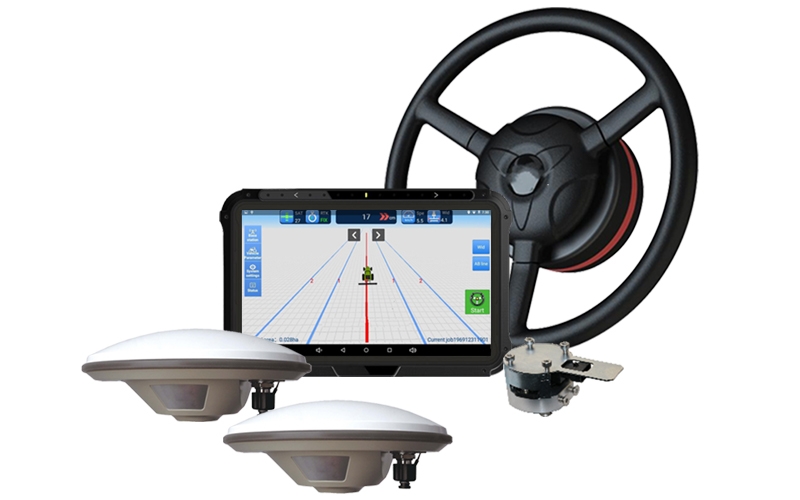What is meant by the rice transplanter GPS system?
- A system that uses GPS technology to transplant rice is called a rice transplanter GPS system. While planting rice, the method enables rice farmers to do so with more accuracy and precision.
- The rice transplanter equipment has a built-in GPS system that uses satellite signals to pinpoint its precise location within the rice field. The depth and spacing of the rice plants are then managed using this information.
- Farmers may boost agricultural yields, decrease seed waste, and achieve more effective planting with the help of the GPS system. The technology also enables farmers to map their fields and track the development of their crops, enabling them to make smarter choices about pest management, irrigation, and fertilization.
- Overall, the rice transplanter GPS system is a useful tool for contemporary rice farming since it enables farmers to operate more accurately and efficiently, resulting in higher yields and profitability.

Which pros does the rice transplanter GPS system offer?
When improving precision, accuracy, and productivity in rice planting, a rice transplanter GPS system effectiveness may be assessed. This transplanter GPS’s efficiency advantages can assist farmers in enhancing their output and profits while minimizing waste and labour-intensive human work. Here are a few advantages of employing this transplanter GPS for efficiency:
- Precision:
The rice transplanter uses GPS technology to properly locate itself in the field and plant rice at specific depths and intervals. In addition to improving the regularity and uniformity of the planting, this can lessen the need for human corrections.
- Time-saving:
The rice transplanter can plant rice more effectively and swiftly with GPS technology than with conventional techniques. Farmers may be able to focus on other areas of their enterprise due to the time and labour cost savings.
- Cost-effective:
The rice transplanter GPS system can assist in decreasing seed loss and boosting crop yields by minimizing the need for human adjustments and optimizing planting depth and spacing. Farmers may be able to reduce expenses. As a result, we are increasing profitability.
- Data gathering:
The GPS system may assist farmers in gathering information on the performance of their farms and crops. Making more educated judgments regarding pest management, irrigation, and fertilizer will result in healthier and more productive crops.
- Precise planting:
Rice seedlings can be planted precisely thanks to GPS technology, which also ensures equal spacing between plants and minimizes overlap and seed loss. Because of the increased planting efficiency, yields are greater, and labor expenses are lower.
- Lower manual labor requirements:
A GPS system for rice transplanter can lower the amount of planting labor that must be done by hand, which lowers labor costs and boosts productivity. The system uses GPS to map the area, design the best planting patterns, and monitor the planting process.
- Profitability improved:
A GPS system for rice transplanter can help farmers become more profitable by enhancing planting effectiveness and crop output. This may result in a more resilient agricultural sector and economic development of rural communities.
The Revolutionary Impact of GPS Technology on Rice Transplanter Operations:
The way farmers plant rice fields is changing thanks to GPS-enabled rice transplanter. These devices can measure and plant rice with incredible accuracy using GPS, which results in increased yields and cheaper labor expenses. With this technology, farming should be more productive, and rice planting should take less time and effort. It gives farmers an accurate and effective planting method, saving them time and money. To ensure that all rice seedlings are planted in the optimum spot, this method uses GPS technology to find the best planting sites precisely. GPS technology is transforming how rice transplanter operate by enhancing accuracy, productivity, and efficiency. This makes it possible for farmers to produce better outcomes and increase their profitability, which promotes a more sustainable and successful agriculture sector. Rice transplanter operations are being transformed by GPS technology in several ways:
- Planting with precision:
Rice seedlings may be planted with the correct depth and spacing thanks to GPS technology. This increases planting efficiency, resulting in greater yields and lower labor expenses.
- Time-saving:
Rice transplanter machines can plant rice more rapidly and effectively than conventional methods using GPS technology. Farmers can concentrate on other business elements since they save time and money on labor.
- Reduced seed waste:
By ensuring that seedlings are planted at the proper depth and distance between, GPS technology can assist in decreasing seed waste by preventing overlap and unused seeds.
- Improved productivity:
GPS technology can help rice farmers become more productive by increasing planting effectiveness and crop production. As a result, the agriculture sector becomes more profitable and sustainable. Rice fields may be mapped using GPS technology, allowing farmers to track the development of their crops and make better operational decisions.
- Data gathering:
With GPS technology, farmers may gather information about the performance of their crops and fields. Making more educated judgments regarding pest management, irrigation, and fertilizer will result in healthier and more productive crops.
Conclusion:
One of the most significant staple foods in many nations worldwide is rice. Rice is a basic meal and is widely farmed in many nations. Yet because growing rice requires a lot of effort, it’s become more crucial than ever to create efficient farming techniques. A major area of study now is the creation of automated rice production systems based on precision agriculture. Among other technologies, a rice transplanter and mapping system based on Global Positioning System (GPS) technology have been created. Farmers can benefit from using a rice transplanter GPS system by getting precise planting and simple planting navigation. With little effort from the user, this method may boost productivity, accuracy, and total revenues. If you know the reasonably priced steering alternatives that SMAJAYU provides, your agricultural operations might be greatly improved. The best course of action for our beloved farmers is to turn farming into an art form.


